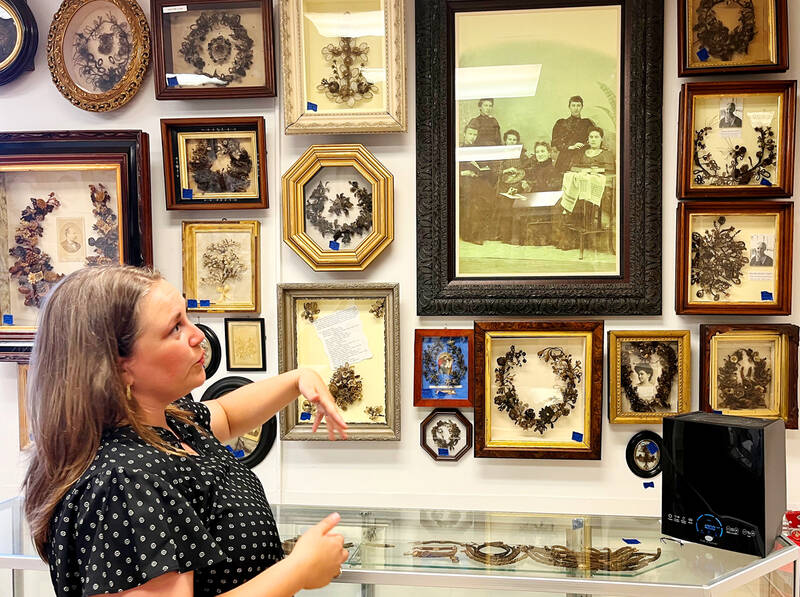Century-old wreaths made from human hair fill the walls of Leila’s Hair Museum, and glass cases overflow with necklaces and watch bands woven from the locks of the dead. There also are tresses purported to come from past presidents, Hollywood legend Marilyn Monroe and even Jesus.
For about 30 years, this hair art collection in the Kansas City suburb of Independence attracted an eclectic group of gawkers that included the likes of heavy metal legend Ozzy Osbourne.
But the museum’s namesake, Leila Cohoon, died last November at the age of 92. Now her granddaughter, Lindsay Evans, is busy rehoming the collection of more than 3,000 pieces to museums across the country, including the Metropolitan Museum of Art in New York, and the National Museum of Women in the Arts in Washington, D.C.

Photo: AP
“Every time I come here, I feel her here,” Evans said Monday while touring with representatives of the National Museum of Funeral History in Houston who left with around 30 pieces. “This place is her. And so I feel like this process of rehoming her collection has helped me grieve her in a way that I didn’t even realize I really needed.”
It all started in 1956 when Cohoon, a hair dresser, was shopping for Easter shoes. Inside an antique store she found a gold frame filled with strands of hair twisted into the shape of flowers.
“She said forget the Easter shoes,” Evans said. “My granddad always said that this was the most expensive piece of the museum because look at what it started.”
Evans is keeping that one for herself.
This form of art peaked in popularity in the mid-1800s as women coiled the hair of the dead into jewelry or told their family history by intertwining the curls of loved ones into wreaths.
But hair art had fallen out of favor by the 1940s, as memories were captured in photos, Evans said. Additionally, “this artwork was not celebrated because it was mostly done by women. And so in larger museums, they don’t have a lot of this.”
Her grandmother saved some from being trashed, wrote a book and taught classes on the art form, training a new generation of artists.
Often the hair art was housed in elaborate frames with original glass, so when her grandmother started haggling with antique dealers for the frames, they frequently offered to get rid of the hair.
“And she’d say, ‘No, no, keep that in there,’” Evans said.
Then her grandmother would hand them her business card and tell them to be on the lookout. Soon dealers across the country were calling.
“If it had hair, she got it,” said Evans, who sometimes accompanied her grandmother as she hunted for new additions.
The collection grew to include a wreath containing hair from every woman in the League of Women Voters from Vermont in 1865. A pair of crescent-shaped wreaths contain the tresses of two sisters whose heads were shaved when they entered a convent. A couple pieces even feature taxidermy.
The frames filled the walls of her home and the beauty school she ran with her husband. She shoved them under beds and in closets. Eventually, the couple snatched up this building — a former car dealership — nestled between a fast-food restaurant and car wash.
Celebrities caught wind of the attraction. Actress and comedian Phyllis Diller donated a hair wreath that had been in her family for generations. TV personality Mike Rowe filmed an episode of “Somebody’s Gotta Do It” here. There might also be a few strands from Osbourne inside. When he came to visit, Cohoon snipped a lock, although Evans has yet to find it.
Evans said her grandmother was tight-lipped on what she spent over the years, but she anticipates the worth of the art may top $1 million.
As Genevieve Keeney, the head of the National Museum of Funeral History in Houston, waded through the collection, she eagerly eyed the jewelry that memorialized the dead, including a small pin containing the locks of a 7-year-old girl who died in 1811.
“I always felt it was important to educate people about death,” said Keeney, also a licensed mortician. “Our society does such an injustice on getting people to understand what the true emotions are going to feel like when death happens.”
Evans herself is struggling with a mix of emotions as she slowly rehomes her grandmother’s legacy.
“I want people to see all of this because that’s what she wanted,” Evans said. “But when this is empty it’ll break my heart a little bit.”

In recent weeks the Trump Administration has been demanding that Taiwan transfer half of its chip manufacturing to the US. In an interview with NewsNation, US Secretary of Commerce Howard Lutnick said that the US would need 50 percent of domestic chip production to protect Taiwan. He stated, discussing Taiwan’s chip production: “My argument to them was, well, if you have 95 percent, how am I gonna get it to protect you? You’re going to put it on a plane? You’re going to put it on a boat?” The stench of the Trump Administration’s mafia-style notions of “protection” was strong

Late last month US authorities used allegations of forced labor at bicycle manufacturer Giant Group (巨大集團) to block imports from the firm. CNN reported: “Giant, the world’s largest bike manufacturer, on Thursday warned of delays to shipments to the United States after American customs officials announced a surprise ban on imports over unspecified forced labor accusations.” The order to stop shipments, from the US Customs and Border Protection (CBP), came as a surprise to Giant, company officials said. Giant spokesman Ken Li (李書耕) said that the CPB never visited the company’s factories to conduct on-site investigations, nor to interview or

Every now and then, it’s nice to just point somewhere on a map and head out with no plan. In Taiwan, where convenience reigns, food options are plentiful and people are generally friendly and helpful, this type of trip is that much easier to pull off. One day last November, a spur-of-the-moment day hike in the hills of Chiayi County turned into a surprisingly memorable experience that impressed on me once again how fortunate we all are to call this island home. The scenery I walked through that day — a mix of forest and farms reaching up into the clouds

“Eighteen years ago, people didn’t even know the name of this ingredient,” says 58-year-old Gil Sa-hyeon, holding up a cluster of dried brownish stems. “Now it’s everywhere.” His shop, Joseon Yakcho, sits in the heart of Seoul’s Yangnyeongsi Market, South Korea’s largest traditional medicinal herb market, its streets lined with shops displaying buckets of herbs such as licorice root and cinnamon bark that spill on to the pavements, filling the air with their distinct, earthy aroma. The ingredient Gil is referring to is hovenia dulcis, known in Korean as heotgae — the oriental raisin tree that’s become the cornerstone of South Korea’s